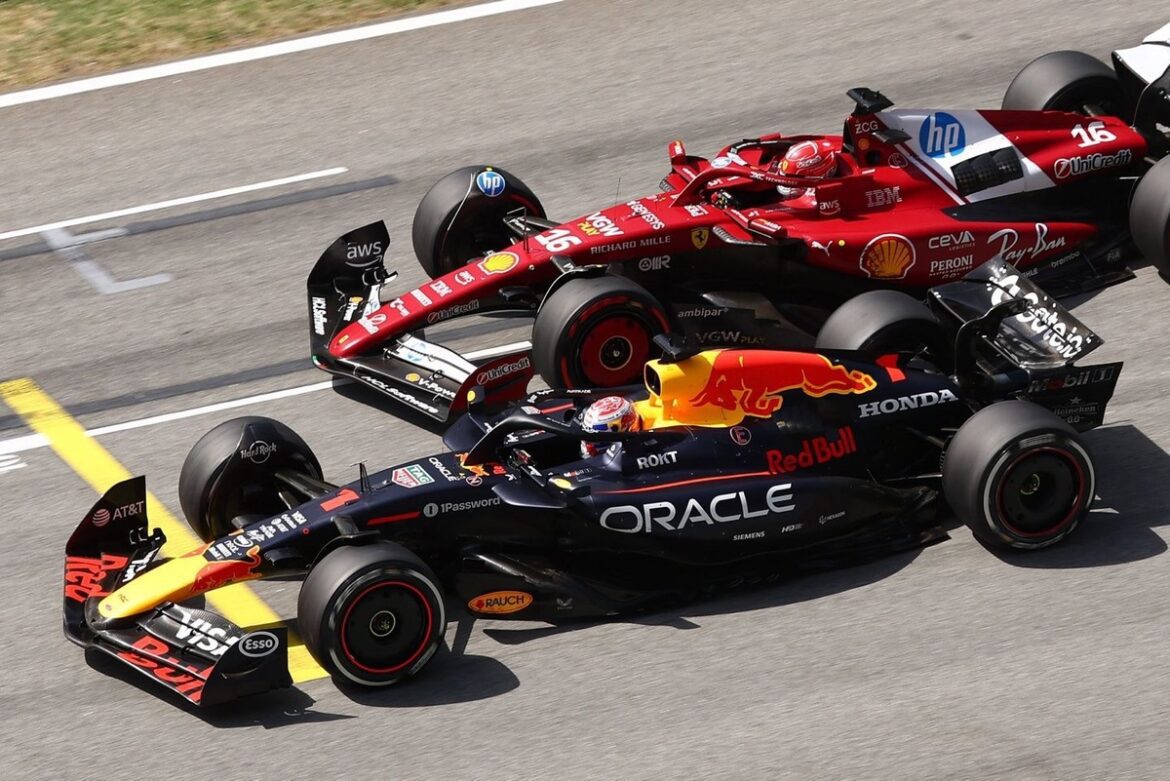FIA Race Stewards’ Decision on Charles Leclerc’s Contact with Max Verstappen at the Spanish Grand Prix
In a recent event during the Formula 1 Spanish Grand Prix, the FIA race stewards have determined that no further action is necessary against Charles Leclerc for a moment of contact with Max Verstappen. This decision has allowed the Ferrari driver to maintain his podium finish in the race.
The Incident During the Race
The incident occurred on lap 61 during a safety car restart. As the race resumed, Verstappen experienced a significant loss of traction due to an oversteer issue while navigating the final corner. This situation left him vulnerable to Leclerc, who was driving closely behind and seized the opportunity to overtake.
While attempting to pass Verstappen, Leclerc appeared to slightly veer towards Verstappen’s car as they raced side by side. This maneuver sparked a debate, as Verstappen believed that Leclerc’s actions warranted a penalty. However, the race stewards examined the incident and concluded otherwise.
Stewards’ Review Process
In their investigation, the stewards gathered testimonies from both drivers involved: Max Verstappen (Car 1) and Charles Leclerc (Car 16). They also consulted with team representatives and analyzed a variety of data sources, including video footage, timing information, telemetry data, team radio communications, and in-car video evidence.
The stewards reported that Verstappen lost traction while tackling Turn 14, which forced him to defend his position against Leclerc. The Ferrari driver then moved to overtake Verstappen on the main straight. The stewards noted that both drivers were slightly drifting towards each other in the middle of the track, which resulted in a minor collision.
In their official statement, the stewards emphasized that both drivers believed the collision could have been avoided and acknowledged the potential for a more serious crash. However, they concluded that neither driver was primarily at fault in this instance, leading to the decision of no further action.
Race Results and Additional Consequences
Following the incident, Max Verstappen finished in 10th place after receiving a 10-second penalty for a separate collision with George Russell earlier in the race. This penalty included three points added to his racing license, bringing him perilously close to a race ban, just one point shy of the limit before the next race in Austria at the end of June.
In contrast, Charles Leclerc successfully secured third place, finishing behind McLaren drivers Lando Norris and Oscar Piastri. This result was significant for Leclerc and Ferrari, as it showcased their competitive performance in the race.
The Implications of the Decision
The stewards’ ruling not only impacted the race results but also highlighted the ongoing discussions about driver accountability and racing incidents in Formula 1. The decision reflects the complexity of racing dynamics, where split-second decisions can lead to contact between cars.
As the season progresses, the relationship between drivers, teams, and the stewards will continue to be scrutinized, especially in high-pressure situations like restarts and overtakes.
The Role of Team Strategy and Driver Performance
In addition to the individual incident between Leclerc and Verstappen, the race also underscored the importance of team strategy and driver performance in Formula 1. The ability to respond quickly to changing conditions, such as a safety car period, can greatly influence the outcome of a race.
For teams like Ferrari and McLaren, strategic decisions regarding tire choices and pit stops can play a pivotal role in enhancing their competitive edge. In this race, McLaren’s strategy paid off, as both Norris and Piastri secured the top two spots, demonstrating the effectiveness of their approach.
The Future of Formula 1 Racing
As Formula 1 continues to evolve, incidents like the one between Leclerc and Verstappen will remain a focal point for drivers, teams, and officials alike. The sport’s governing body, the FIA, is tasked with ensuring fair competition while also maintaining the excitement that comes with close racing and high-stakes situations.
The ongoing discussions about racing incidents and penalties will likely shape future regulations and enforcement practices. With the increasing competitiveness of the teams and the skill level of the drivers, the stakes are higher than ever, making every decision critical to success on the track.
Conclusion
The recent ruling by the FIA stewards regarding the contact between Charles Leclerc and Max Verstappen serves as a reminder of the intricate dynamics present in Formula 1 racing. As teams and drivers navigate the complexities of competition, the focus on maintaining fairness and safety will remain paramount.
With the season still unfolding, fans can look forward to more thrilling races and perhaps further discussions around the rules and their application in the world of Formula 1.
